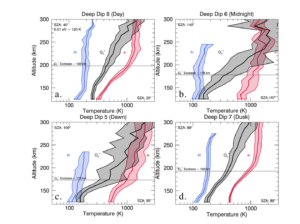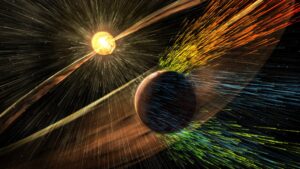The MAVEN team is conducting exciting, new scientific research every day! Many of these results are published in leading academic journals. Each month, we’ll be highlighting an interesting paper in a jargon-free format. This month, we looked at “In Situ Measurements of Thermal Ion Temperature in the Martian Ionosphere”, which Gwen Hanley and colleagues published in JGR Space Physics in December 2021.
The mystery started with some new measurements. For the first time since 1976, scientists successfully measured the temperature of ions in Mars’ atmosphere using the MAVEN spacecraft. Ions are electrically charged particles created when light from the Sun knocks an electron off a gas molecule in a planet’s atmosphere, creating plasma. Hotter ions have more energy, so they can easily overcome gravity and reach altitudes where electromagnetic forces can help them escape into space. Knowing more about ion escape is one piece to the puzzle of understanding how Mars lost its early atmosphere.
Collisions cause ions to lose energy and therefore cool off, so scientists have long theorized that the temperatures of the ions and the surrounding, electrically neutral particles—called neutrals—would be the same in the highly collisional atmosphere below a boundary called the ‘exobase.’
But when a team of scientists led by Berkeley graduate student Gwen Hanley analyzed new measurements from MAVEN’s Suprathermal and Thermal Ion Composition (STATIC) instrument, they found that—much to their surprise—this is not the case.
Modelers of Mars’ atmosphere must make assumptions in order to find initial and boundary conditions, which are the starting point and the guides that the model must adhere to in order to function properly. For models that calculate ion temperatures, the most common assumption has been that the temperatures of the ions and the neutrals (for Mars, molecular oxygen and carbon dioxide , respectively) become the same below the exobase. This is because in this part of the atmosphere, ions collide with neutral gas particles dozens or hundreds of times per second, which should lead them to cool off to the same temperature as the neutrals.
To test this long-held theory, the MAVEN team examined data from a series of special flight maneuvers, playfully called Deep Dips, during which the MAVEN spacecraft adjusted its orbit to fly into the peak of the ionosphere, about 120 km above the surface. Using the measurements obtained there, Hanley and her team found that the temperatures of the neutrals and the ions did not converge. In fact, the ions remained more than 100 Kelvin hotter than the neutrals—a significant temperature difference.

To get to the bottom of the Case of the Hot Ions, the team investigated many possible suspects—sources of energy that might account for the hotter-than-expected temperatures they had discovered. But in the end, the team was unable to find a mechanism that could deposit enough energy into the ions quickly enough to keep them significantly hotter than the neutrals, per their findings. So in the process of solving one mystery, they encountered an entirely new one—that a fundamental physical process operating in Mars’ atmosphere is in fact missing from all of our scientific models.
While this new case remains open, Hanley and other scientists will continue searching for the elusive culprit and learn more about the Red Planet’s atmospheric evolution in the process. After all, science often leads us to more questions than answers.
To read Hanley’s publication, visit: https://agupubs.onlinelibrary.wiley.com/doi/10.1029/2021JA029531
Written by Willow Reed – MAVEN Communication Specialist


